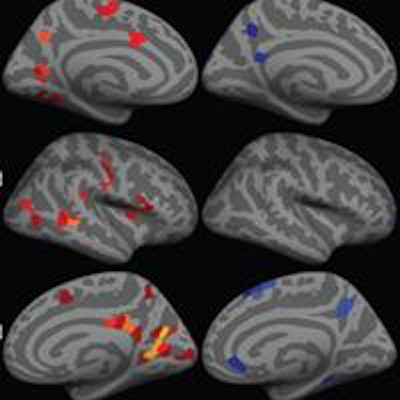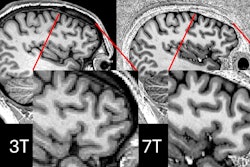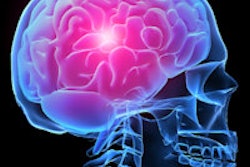
Diffusion-tensor MRI (DTI-MRI) has shown widespread, abnormal connections in the brains of patients with temporal lobe epilepsy, which could help with diagnosis and treatment, according to a new study published online November 19 in Radiology.
Researchers from Massachusetts General Hospital found evidence of structural brain alterations beyond the temporal lobe, especially in the brain's default mode network, which consists of regions that function during rest and are less active when a person performs goal-oriented tasks.
The group found a significant decrease in long-range conductivity and increases in local connectivity within and beyond the default mode network, which could be caused by the loss of white brain matter due to temporal lobe epilepsy. Thus, DTI-MRI images of the structural changes may offer a noninvasive biomarker for diagnosing and monitoring patients with temporal lobe epilepsy.
Lead author Dr. Matthew DeSalvo initiated the study as a medical student with the help of a 2013 medical student grant from RSNA (Radiology, November 19, 2013).
Temporal lobe epilepsy
Temporal lobe epilepsy accounts for approximately half of all focal epilepsy cases and is characterized by seizures originating in the temporal lobes.
Previous studies indicated that the condition is caused by isolated injury of regions such as the hippocampus within the temporal lobe. However, more recent research suggests that regions of the brain known as the default mode network (DMN) may play a greater role in the affliction.
In the current study, DeSalvo and colleagues retrospectively reviewed data from 24 patients with left temporal lobe epilepsy who were scheduled for surgery to remove the site from which their seizures originated. The mean age of the subjects was 17 years, ranging from 1 to 52 years.
The researchers also evaluated 24 healthy control subjects who were matched for age and sex and were evaluated between April 2007 and December 2012. DTI-MRI was performed using a 3-tesla scanner (Tim Trio, Siemens Healthcare) to track the movement -- or diffusion -- of water in the brain's white matter.
Among the 48 patients, 60 direction DTI and magnetization-prepared rapid acquisition gradient-echo (MP-RAGE) MRI volumes were analyzed. MP-RAGE volumes were segmented into 1,015 regions of interest (ROIs) spanning the entire brain.
Decreased conductivity
Patients with left temporal lobe epilepsy showed a 22% to 45% decrease in long-range connectivity in the medial orbitofrontal cortex, temporal cortex, posterior cingulate cortex, and precuneus, compared with healthy subjects, according to DeSalvo and colleagues.
However, local connectivity in patients with left temporal lobe epilepsy increased by 85% to 270% in the medial and lateral frontal cortices, insular cortex, posterior cingulate cortex, precuneus, and occipital cortex, compared with the control subjects.
The researchers speculated that the finding may be the brain adapting locally to the loss of long-range default mode network connections.
"The increase in local connections could represent a maladaptive mechanism by which overall neural connectivity is maintained despite the loss of connections through important hub areas," they wrote.
 Inflated cortical surface representations show the significant differences across 1,015 regions of interest between the group of patients with temporal lobe epilepsy (TLE) and healthy subjects. Red, orange, and yellow indicate increases in TLE, while blue indicates decreases. Image courtesy of Radiology.
Inflated cortical surface representations show the significant differences across 1,015 regions of interest between the group of patients with temporal lobe epilepsy (TLE) and healthy subjects. Red, orange, and yellow indicate increases in TLE, while blue indicates decreases. Image courtesy of Radiology."Our principal finding was that structural connectivity was decreased throughout the DMN, as measured with both within-module and between-module connectivity," DeSalvo and colleagues concluded. "This suggests that the DMN may have a reduced role as the structural hub of brain connectivity in patients with temporal lobe epilepsy."
The study's results are supported by previous functional MRI research that showed decreased functional connectivity in DMN areas in patients with temporal lobe epilepsy. However, it is not known for certain if these structural changes cause the functional alterations or vice versa.
The researchers plan to extend their study using structural and functional MRI with electroencephalography and magnetoencephalography to track diffusion changes and to look at real-time brain activity.
The long-term goal is to see if they can predict from diffusion studies which patients will respond to surgery and which patients will not.
The study is part of the Human Connectome Project, a five-year project funded by the U.S. National Institutes of Health that uses neuroimaging techniques to study connectomics, or the functional and structural connections in the brain.


.fFmgij6Hin.png?auto=compress%2Cformat&fit=crop&h=100&q=70&w=100)





.fFmgij6Hin.png?auto=compress%2Cformat&fit=crop&h=167&q=70&w=250)











